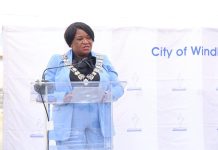Africa-Press – Namibia. THE Development Bank of Namibia has announced a facility to finance climate change adaptation, with up to N$410 million per borrower available.
Probably the first of its kind in Namibia, the facility aims to bolster the bank’s long track record of finance with beneficial environmental and social initiatives, says the bank’s chief executive, Martin Inkumbi.
The facility provides an affordable and tailored financing solution for climate and environmentally-friendly projects, says Inkumbi. It is not clear what interest rate the bank will offer, or whether it will be collateralised.
Inkumbi does, however, say that the funding term could be up to 10 years, with a grace period of up to three years, according to individual borrowers’ profiles. The initiative comes amid concentrated efforts globally and on the continent, to fund climate-proof projects.
The African Development Bank recently put out a call for applications for the first edition of the African Youth Adaptation Solutions Challenge, with a win of up to N$1,4 million.
DBN has financed low-carbon renewable energy generation, water reclamation for industrial use at Walvis Bay and water storage at Neckartal Dam, among other initiatives. Inkumbi says finance for climate adaptation is important, and there are a range of affordable financing instruments for such business projects.
DBN has already pioneered financing models for renewable energy, Inkumbi says, and are now setting their sights on energy- and water-use efficiency, as well as mitigating the effects of rising temperatures.
Inkumbi says DBN, which has a loan book of about N$10 billion, has funded climate-linked projects before, such as water capturing through the Neckartal Dam, but in the face of the prolonged drought, there is an opportunity for enterprises to invest in water efficiency.
Investing in technology and processes that are energy- and water-efficient, reduces the amount of energy and water consumption per output for a business, which lowers production and/or operational costs and improves profitability.
Although water efficiency will not alleviate drought, it can lead to improvements in the enterprise’s bottom line, in addition to preserving the environment.
Inkumbi urges enterprises to examine their energy and water usage and develop innovative methods to reduce usage and associated costs. He says there is still scope for development in terms of water recycling, reclamation, and storage in abattoirs.
On the topic of rising temperatures, Inkumbi noted that there is a twofold cost. First, the cost of cooling facilities, and second, the cost of mitigating health issues caused by rising heat levels.
The cost of cooling facilities adds to the cost of an enterprise and also places a burden on power generation. Constructing plants and facilities with heat dissipation in mind can help mitigate these conditions.
He espouses the benefits of energy-efficient housing developments because incorporating heat dissipation reduces the costs of running a household, and improves the health of residents.
This, he says, dovetails well with the bank’s finance for affordable housing projects. The bank will de-risk innovative projects with extensive due diligence on innovation, says Inkumbi. In this way, DBN hopes to pioneer finance for climate change adaptation.
Inkumbi calls on engineers, architects, consultants, and project managers to lean more towards energy- and water-efficient designs, and for businesses to approach the bank for finance.






